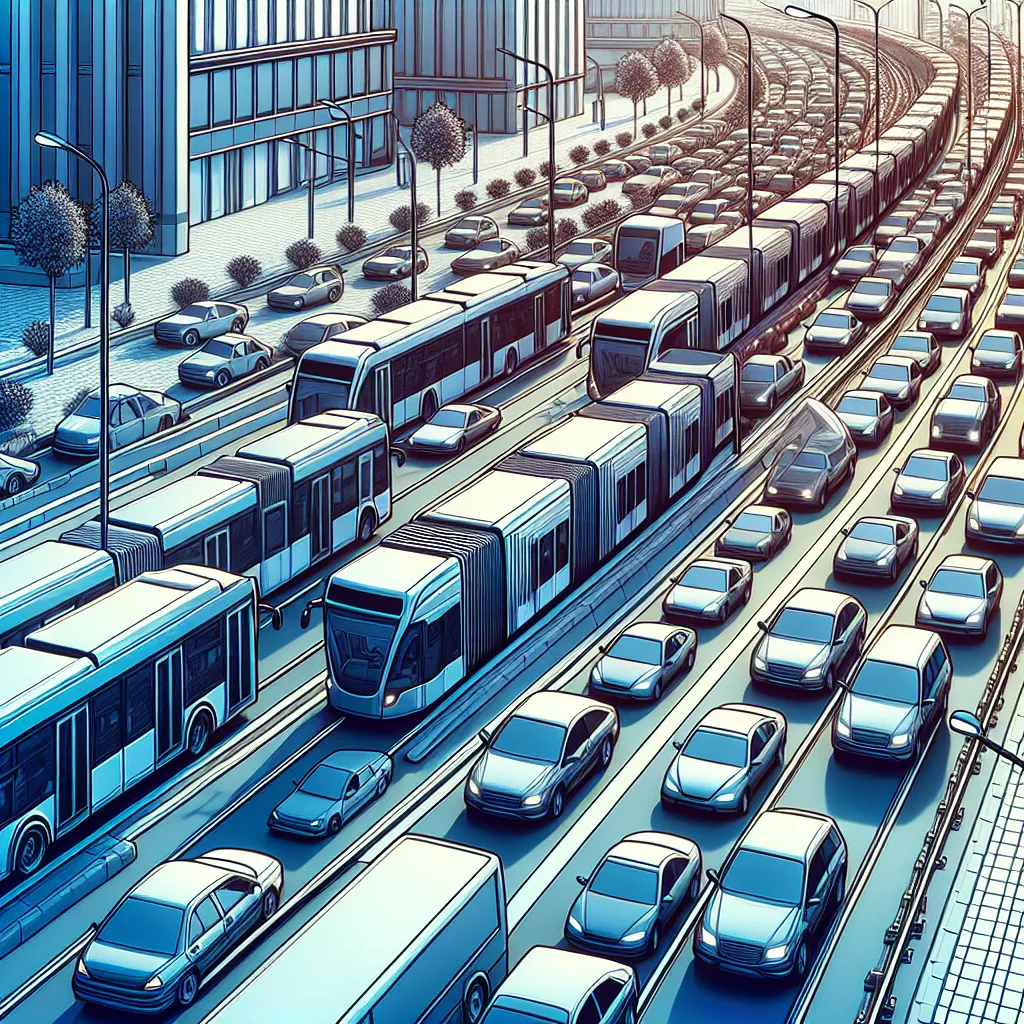Welcome to our IELTS Reading practice test focused on the topic of “How public transportation is reducing urban congestion.” This comprehensive test will help you prepare for the IELTS Reading section while exploring an important urban development issue. Let’s dive into the passages and questions!
 Public transport reducing urban congestion
Public transport reducing urban congestion
Passage 1 (Easy Text)
The Rise of Public Transportation in Cities
Public transportation has become an essential component of urban life in the 21st century. As cities grow and expand, the need for efficient and sustainable mobility solutions has never been more critical. Municipalities worldwide are investing heavily in public transit systems to address the pressing issue of urban congestion.
One of the primary benefits of public transportation is its ability to move large numbers of people in a relatively small space. A single bus can carry up to 60 passengers, effectively removing dozens of cars from the road. Similarly, a metro train can transport hundreds of commuters in one journey, significantly reducing the number of vehicles on city streets.
Moreover, public transportation contributes to a reduction in carbon emissions. As more people opt for buses, trains, and trams instead of private cars, the overall carbon footprint of urban areas decreases. This shift not only helps combat climate change but also improves air quality in cities, making them more livable for residents.
Many cities are also implementing dedicated bus lanes and priority signals for public transport vehicles. These measures ensure that buses can move swiftly through traffic, making them a more attractive option for commuters. By providing a faster and more reliable alternative to private cars, public transportation encourages more people to leave their vehicles at home, further reducing congestion.
The integration of different modes of public transport has also played a crucial role in reducing urban congestion. Many cities now offer seamless connections between buses, trains, and other forms of public transit, making it easier for passengers to complete their journeys efficiently. This interconnected approach to public transportation helps create a more comprehensive and user-friendly system, attracting more riders and reducing reliance on private vehicles.
Questions 1-5
Do the following statements agree with the information given in the passage?
Write:
TRUE if the statement agrees with the information
FALSE if the statement contradicts the information
NOT GIVEN if there is no information on this
- Public transportation has become less important in the 21st century.
- A single bus can carry up to 60 passengers.
- Public transportation helps reduce carbon emissions in cities.
- All cities have implemented dedicated bus lanes.
- The integration of different modes of public transport has contributed to reducing urban congestion.
Questions 6-10
Complete the sentences below.
Choose NO MORE THAN TWO WORDS from the passage for each answer.
- A ___ can transport hundreds of commuters in one journey.
- Many cities are implementing ___ for public transport vehicles to ensure they can move swiftly through traffic.
- Public transportation contributes to improving ___ in cities.
- The ___ of different modes of public transport has played a crucial role in reducing urban congestion.
- An interconnected approach to public transportation creates a more ___ and user-friendly system.
Passage 2 (Medium Text)
Innovative Approaches to Public Transportation
As urban populations continue to grow, cities around the world are adopting innovative approaches to public transportation to combat congestion and improve mobility. These strategies go beyond traditional bus and rail systems, incorporating cutting-edge technologies and creative solutions to meet the evolving needs of urban commuters.
One such innovation is the implementation of Bus Rapid Transit (BRT) systems. BRT combines the capacity and speed of a light rail or metro system with the flexibility and lower cost of a bus service. These systems typically feature dedicated lanes, off-board fare collection, and level boarding, allowing for faster and more efficient travel. Cities like Bogotá, Colombia, and Curitiba, Brazil, have successfully implemented BRT systems, significantly reducing travel times and easing congestion on major corridors.
Another emerging trend is the integration of shared mobility services with public transportation networks. Many cities are partnering with bike-sharing, e-scooter, and car-sharing companies to provide first and last-mile solutions. This approach helps bridge the gap between public transit stops and passengers’ final destinations, making it more convenient for people to use public transportation for their entire journey.
Smart technology is also playing a crucial role in enhancing public transportation efficiency. Real-time tracking systems, mobile apps, and digital payment solutions are making it easier for passengers to plan their trips, check schedules, and pay for fares. These technological advancements not only improve the user experience but also help transit agencies optimize routes and schedules based on ridership data.
Some cities are experimenting with demand-responsive transit services, which operate similarly to ride-hailing apps but use larger vehicles like minibuses. These services can adjust their routes and schedules based on real-time demand, providing a more flexible and efficient alternative to fixed-route buses in areas with lower population density.
The concept of transit-oriented development (TOD) is gaining traction as a way to reduce congestion by designing communities around public transportation hubs. TOD encourages high-density, mixed-use development near transit stations, reducing the need for car ownership and promoting walking, cycling, and public transit use.
As cities continue to innovate in the realm of public transportation, the potential for reducing urban congestion grows. By combining these various approaches and tailoring solutions to local needs, municipalities can create more efficient, sustainable, and livable urban environments.
Questions 11-14
Choose the correct letter, A, B, C, or D.
-
According to the passage, Bus Rapid Transit (BRT) systems:
A) Are more expensive than light rail systems
B) Have the same capacity as traditional bus services
C) Combine features of rail and bus systems
D) Are only successful in South American cities -
The integration of shared mobility services with public transportation:
A) Replaces the need for traditional public transit
B) Only includes bike-sharing services
C) Helps solve the first and last-mile problem
D) Is not yet implemented in any cities -
Smart technology in public transportation:
A) Is only used for fare payment
B) Helps optimize routes and schedules
C) Is not popular among passengers
D) Increases operational costs for transit agencies -
Demand-responsive transit services:
A) Use the same vehicles as traditional bus services
B) Only operate on fixed routes
C) Are not influenced by real-time demand
D) Can adjust their routes based on passenger needs
Questions 15-19
Complete the summary below.
Choose NO MORE THAN TWO WORDS from the passage for each answer.
Cities are adopting innovative approaches to public transportation to combat congestion. Bus Rapid Transit systems combine the benefits of rail systems with the (15) of bus services. Many cities are partnering with (16) companies to provide first and last-mile solutions. (17) is enhancing public transportation efficiency through real-time tracking and mobile apps. Some cities are experimenting with (18) services that can adjust their routes based on demand. The concept of (19) ___ encourages development around public transportation hubs to reduce car dependency.
Passage 3 (Hard Text)
The Economic and Social Impacts of Improved Public Transportation
The implementation of efficient public transportation systems in urban areas has far-reaching consequences that extend beyond merely reducing congestion. These systems catalyze a myriad of economic and social benefits that contribute to the overall well-being of cities and their inhabitants. Understanding these multifaceted impacts is crucial for policymakers and urban planners as they seek to create sustainable, equitable, and prosperous urban environments.
From an economic perspective, improved public transportation can significantly enhance a city’s productivity and competitiveness. By reducing travel times and improving accessibility, public transit systems expand labor market opportunities, allowing employers to access a wider pool of talent and employees to reach a broader range of job opportunities. This increased mobility can lead to better job matching, potentially raising overall productivity and wages. Moreover, the reduction in congestion-related costs, such as wasted fuel and lost productivity due to traffic delays, can result in substantial economic savings for both individuals and businesses.
Public transportation investments also have a multiplier effect on local economies. The construction and maintenance of transit infrastructure create jobs directly, while improved accessibility can stimulate economic activity in areas served by new or enhanced transit options. This can lead to increased property values, new business opportunities, and urban regeneration in previously underserved areas. Furthermore, by reducing the need for extensive parking facilities in urban centers, public transit can free up valuable land for more productive uses, such as commercial or residential development.
From a social equity standpoint, robust public transportation systems play a crucial role in promoting inclusivity and access to opportunities. For low-income individuals, who may not have access to private vehicles, reliable and affordable public transit is often the primary means of accessing employment, education, healthcare, and other essential services. By expanding mobility options, cities can help reduce social isolation and enhance the quality of life for disadvantaged communities.
The environmental benefits of public transportation also have significant social implications. Reduced air pollution from decreased private vehicle use can lead to improved public health outcomes, particularly for vulnerable populations such as children and the elderly. Lower levels of traffic noise can contribute to better mental health and overall well-being for urban residents.
However, the implementation of public transportation systems is not without challenges. The spatial mismatch between where people live and work can make it difficult to design transit networks that effectively serve all communities. Additionally, the phenomenon of transit-induced gentrification – where improved public transportation leads to increased property values and displacement of long-term residents – must be carefully managed to ensure that the benefits of transit investments are equitably distributed.
To maximize the positive impacts of public transportation, cities must adopt holistic approaches that integrate transit planning with broader urban development strategies. This includes promoting transit-oriented development, implementing inclusive zoning policies, and ensuring that transit systems are designed to meet the needs of diverse user groups. Additionally, the use of innovative financing mechanisms, such as value capture schemes, can help fund transit improvements while ensuring that the economic benefits are shared more broadly.
As cities continue to grapple with the challenges of urbanization and sustainable development, the role of public transportation in shaping urban economies and societies will only grow in importance. By recognizing and leveraging the multifaceted impacts of public transit, cities can create more vibrant, equitable, and resilient urban environments for all their residents.
Questions 20-23
Choose the correct letter, A, B, C, or D.
-
According to the passage, improved public transportation:
A) Only reduces congestion in urban areas
B) Has limited economic benefits for cities
C) Has wide-ranging economic and social impacts
D) Is primarily beneficial for businesses -
The multiplier effect of public transportation investments refers to:
A) The direct creation of jobs in transit construction
B) The broader economic stimulation resulting from improved accessibility
C) The increase in property values near transit stations
D) The reduction in parking facilities in urban centers -
The passage suggests that public transportation:
A) Is not important for low-income individuals
B) Has no impact on social equity
C) Can help reduce social isolation
D) Is only beneficial for accessing employment -
The concept of transit-induced gentrification refers to:
A) The deliberate displacement of long-term residents
B) The improved quality of life for all residents near transit
C) The increase in property values and potential displacement due to improved transit
D) The equal distribution of transit benefits to all communities
Questions 24-26
Complete the sentences below.
Choose NO MORE THAN TWO WORDS from the passage for each answer.
- The ___ between residential and employment areas can make it challenging to design effective transit networks.
- Cities must adopt ___ that integrate transit planning with broader urban development strategies.
- ___ can be used to fund transit improvements while ensuring broader distribution of economic benefits.
Questions 27-30
Do the following statements agree with the claims of the writer in the passage?
Write:
YES if the statement agrees with the claims of the writer
NO if the statement contradicts the claims of the writer
NOT GIVEN if it is impossible to say what the writer thinks about this
- Public transportation investments always lead to urban regeneration in underserved areas.
- Reduced air pollution from public transportation use can improve public health outcomes.
- The challenges of implementing public transportation systems are insurmountable.
- Integrating transit planning with urban development strategies can maximize the positive impacts of public transportation.
Answer Key
Passage 1
- FALSE
- TRUE
- TRUE
- NOT GIVEN
- TRUE
- metro train
- priority signals
- air quality
- integration
- comprehensive
Passage 2
- C
- C
- B
- D
- flexibility
- shared mobility
- Smart technology
- demand-responsive transit
- transit-oriented development
Passage 3
- C
- B
- C
- C
- spatial mismatch
- holistic approaches
- Innovative financing mechanisms
- NO
- YES
- NO
- YES
This IELTS Reading practice test on “How public transportation is reducing urban congestion” covers various aspects of the topic, from basic concepts to more complex economic and social impacts. By working through these passages and questions, you’ll not only improve your reading skills but also gain valuable insights into this important urban development issue.
Remember to practice regularly and analyze your performance to identify areas for improvement. Good luck with your IELTS preparation!
For more IELTS practice materials and tips, check out our articles on the importance of public transportation in reducing urban congestion and the impact of autonomous vehicles on transportation systems.


